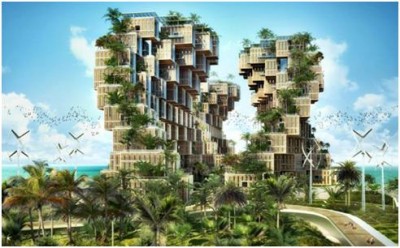If you’re our loyal reader you should remember amazing eco concept of Vincent Callebaut – Lilypad. But Vincent continues to pump out amazing concepts of futuristic eco systems. This time inspired by the organic form of coral he has created utopian eco villages for 1,000 Haitian families affected in 2010 by an earthquake measuring 7.0 on the Richter scale. This village has been named the Coral reef eco village.
Built upon seismic piers off the coast of the mainland, the prefabricated, modular units can be fit into a wave-like matrix as space is needed. Each family would have a plot of land to grow their own food. A canyon flows between two rows of housing and is filled with a tropical ecosystem for the local fauna and the flora.
Aquaculture farms and grey water recycling plants filter and process the water before sending it into the sea. The entire complex is carbon neutral and powered via a number of different renewable energy sources. Power would be generated from thermal energy conversion under the pier, marine currents, vertical axis wind turbines, and solar photovoltaics.
It had been a long time ago when we were reporting about futuristic concept of a city or building, but you will like this particular one by Vincent Callebaut. This utopian eco village, or Callebaut’s Coral Reef, is an artificial pier resting on seismic piles in the Caribbean Sea. I believe that the vision of this is to create new housing projects for people of Haiti that have been left devastated by the earthquake.
Of course, that is pretty high price housing, and who knows who will offer to fund the system and make the concept to turn in real. Still, the housing is modular and each family is to have a plot of land to grow their individual food. See what else my Source’s Source says about it after the jump. Eco villages’ concept is common and many of the best villages around world have been named as eco villages because of preserved natural beauty there.
A canyon flows between two rows of housing and is filled with a tropical ecosystem for the local fauna and the flora. Aquaculture farms and grey water recycling plants filter and process the water before sending it into the sea. The entire complex is carbon neutral and powered via a number of different renewable energy sources. Power would be generated from thermal energy conversion under the pier, marine currents, vertical axis wind turbines, and solar photovoltaics.


